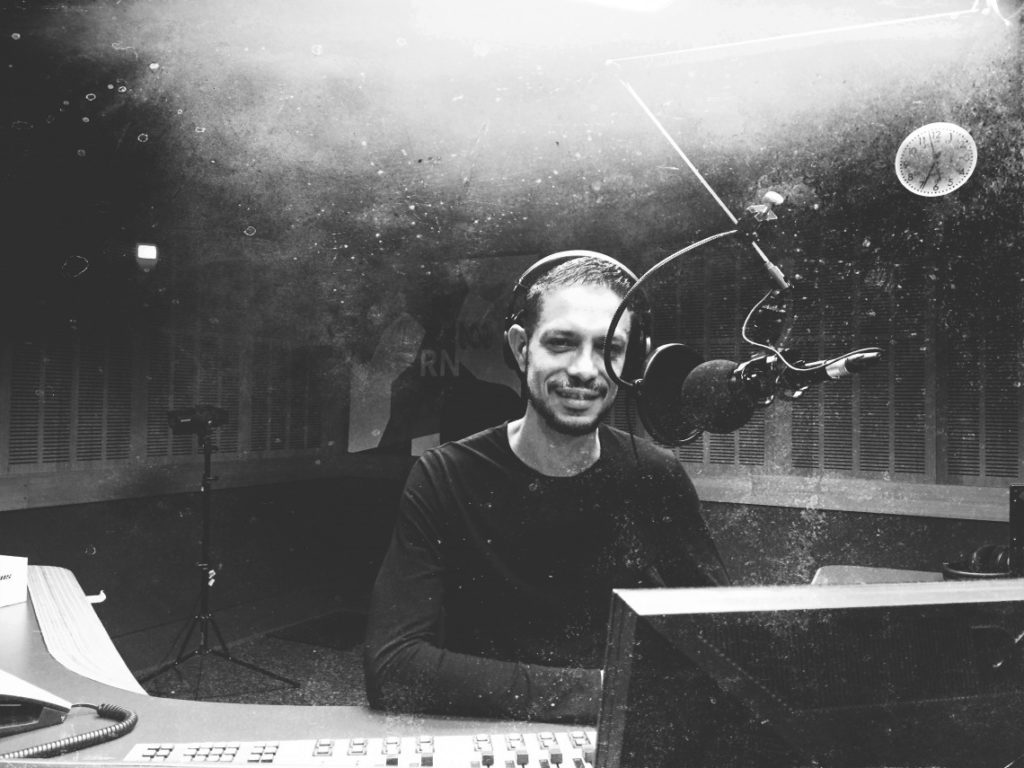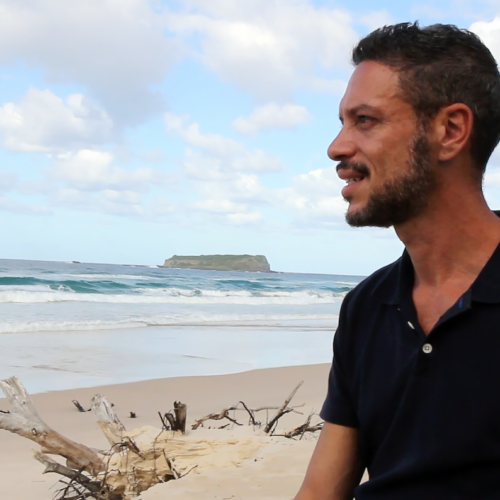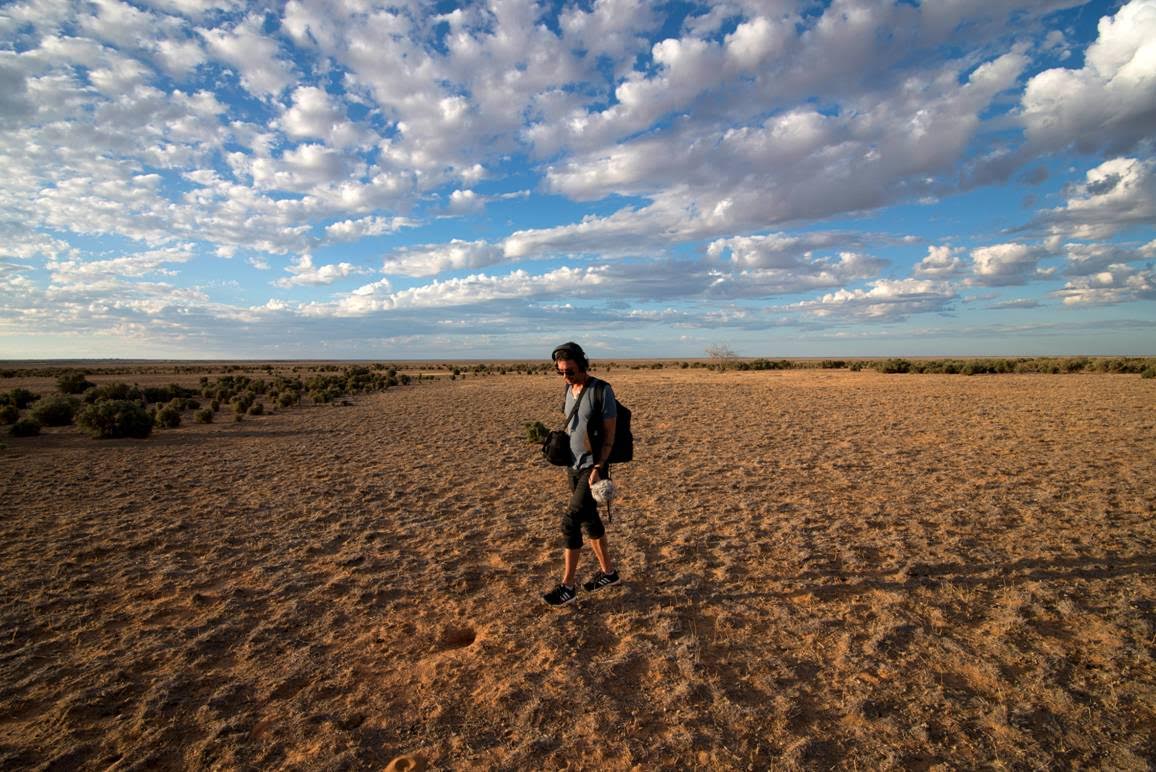Daniel Browning is the presenter of AWAYE! on Radio National. We spoke to him about Word Up – an AWAYE! spin-off series about Aboriginal languages, the necessity of patient interviewing, and how radio reporting brings you into people’s lives.

What piece of audio has had the most profound effect on you – as a listener, as an audio maker or both?
The piece of audio I can’t get out of my head is a 1965 documentary by the ABC journalist Darce Cassidy. He was on the road with activists from the University of Sydney – led by the late Charles Perkins – as they tried to expose racism and segregation in parts of western New South Wales.
It’s a fine piece of on-the-spot reportage, if nothing else. Darce gets his hands dirty, so to speak, and at one point he records a confrontation in the street: think townspeople brandishing pitchforks. He captures the messy, irrational way racism articulates itself – and the mob mentality that drives it. I can hear the breaking voice of a lone Aboriginal woman as she tries to argue truth to power during that confrontation that Darce recorded. In that sense, it’s not historical.
Where did the idea for Word Up come from?
Word Up is a series about Aboriginal languages. Every week, we invite speakers and language workers to share a few words from their mother tongue. What always surprises me about our languages is their versatility – there is so much metaphor and double meaning. They perfectly describe this country, and they articulate a way of seeing and being in the world.
Keeping languages alive is not a nostalgia project.
The idea had been simmering away for a while, but it got real when I was asked to present at a live event at the Wheeler Centre in Melbourne last September. I was asked to moderate and present a word from my language – Bundjalung – which is from the far north coast of New South Wales. I was asked to pick one word, but I found that pretty hard. I picked three or four in the end:
• burudjam – your sister’s male child, your nephew
• baraygir – the top of the trees, the youngest child, the highest point
• dagay – white person, ghost, corpse
Each of the words reminded me of the kind of subjectivity that’s inherent in language. In Aboriginal languages, there’s a real echo of the past, and if languages are maintained and revitalised, a sense of a possible future. Keeping languages alive is not a nostalgia project. In our languages, Aboriginal people are central – not peripheral – and for me, that’s why we need to retain them.
What is your favourite part of making Word Up?
My favourite part is meeting people who are learning their language and discovering how it brings meaning and belonging to their lives. It sounds over the top, but it’s true. If it wasn’t for the people I interview, and the way they generously share their lives – and occasionally, their innermost thoughts – I wouldn’t do it.
For me, it’s also fortifying to meet other Aboriginal people, and to hear how they contend with life in this country, in 2017.
What is the hardest part of producing Word Up?
The hardest part is what you lose in the editing process. Only the maker knows what doesn’t make the cut.
What’s the best thing about working with sound?
The best thing about working with sound is the simplicity of it. As a journalist, I feel my greatest responsibility is to tell the truth, and sound can be unvarnished and raw. I’m less drawn to the dramaturgy, the over-direction, that seems to characterise so much audio storytelling – I prefer my characters to be messily drawn, without make-up. You can hear so much emotion in the human voice.
I’m less drawn to the dramaturgy, the over-direction, that seems to characterise so much audio storytelling – I prefer my characters to be messily drawn, without make-up.
What’s the best (or worst) advice you’ve received about radio?
The best and worst piece of advice I’ve been given about radio was many years ago. The K.I.S.S. principle – Keep It Simple Stupid.
It doesn’t always apply, though. As a news journalist, it might work some of the time, but good stories are complex. The best listeners abide with a story, and know they’ll be rewarded.
What has been your biggest lesson as a producer so far?
The biggest lesson I’ve learned is to be patient, and that to build genuine rapport, you have to spend time with people. To them, your story is secondary. Sometimes you have to think like they do, and bide your time until it’s right.
It’s easy to forget that when someone agrees to be interviewed, they are surrendering some of their privacy. The best interview subjects know that and go with it. I’ve interviewed very senior Aboriginal artists, for whom English is a fourth or fifth language. I remember one from the East Kimberley grabbed the microphone and interviewed herself, popping wildly all the way. I was just a sound recordist. I got schooled that time.

Do you interact with your audience, or receive feedback or criticism about your work?
Yes, and yes. ABC listeners are generally pretty vocal about what they like and don’t like. The criticism can be harsh, particularly when it’s racially motivated. It’s a difficult space in which to work, and it can be challenging to filter out the white noise. Feedback is very hard to find – and of course, it’s subjective. Unfortunately, I tend to listen acutely to the negative, and generally ignore the positive.
If you could go out to dinner with any audio maker, who would it be – and what would you talk about?
In 2008 I was a judge in the radio documentary category for the Prix Italia, so I got locked in a windowless room in Sardinia with audio makers from most of western Europe, listening to features in Croatian, Italian, Dutch and English. I was certainly the only brown person in that room, if not the entire Prix. Anyway, that’s where I first met the Swedish radio maker Martin Johnson. He was in competition for a feature about his deeply fractured relationship with his absent father, a stunning piece called ‘My Father Takes A Vacation’. I’d like to have dinner with Martin again.
What are you listening to at the moment?
One podcast that had a big impact on me recently was an episode of Here Be Monsters. It’s called ‘Redwoods of the In-World’, and it’s about a person with multiple personas – personas that seem to have been a response to trauma. I remember one of the personas says something like, ‘I am who I am, and who I am is they’. It’s gripping.
To build genuine rapport, you have to spend time with people. To them, your story is secondary.
What’s your favourite Australian podcast, and why?
Bowraville by Dan Box, and Curtain, the investigative series by Amy McQuire and Martin Hodgson. Both of them ask profound questions about innocence and guilt, and the way the justice system fails Aboriginal people.
What do you think is unique about Australian audio?
That’s a hard question to answer, but I’d say Australians are different in the way they tell their stories. There’s more restraint and perhaps less dramaturgy in the storytelling.
What’s next for you as a producer?
I’ve just produced a five-part series about the 1967 Referendum, with five voices representing the decades since the vote. There are a range of voices, some expressing hope and others disillusionment. Next up, I’m working on a series about the way that museum objects – hidden from view in storage – can disrupt public memory.
